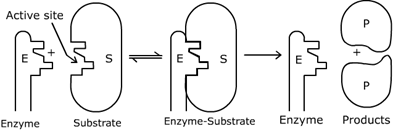Enzymes:- Enzymes are defined as the bio-chemical catalysts. Chemically they are globular proteins with higher molar masses ranging from 15000 to 1000,000 g mol-1
- they catalyses the Biological reactions.
Examples:-


Characteristics of Enzymes:-
- Specificity:- each enzyme can catalyse only one reaction.
Ex.
- Efficiency:-Enzymes are very efficient Catalysts the speed up the rate of reaction by factorof upto 1020.
- Optimum tempreture and pH:- enzyme catalyzed reactions have maximum rate at physiological pH around 7.4 and human body tempreture of 37oC (310 K) under atmospheric pressure.
- Enzyme activators:– the activity of certain enzymes is increased in the presence of certain substances called Co-enzymes.
For example metal ions Na+, Mn+2 are Co-enzymes. - Enzyme inhibitors:- the activity of the enzymes is gets slowed down in the presence of certain substances. Which are called the inhibitors or poisons.
Mechanism of enzyme catalysis:-
Mechanism of enzyme catalyzed reaction is known as lock and key Mechanism.
- Enzymes are highly specific in their action
- There specificity is due to the presence of active sites. The shape of active site of any given enzyme is like acavity such that only a specific substrate can fit into it. In the same way a key fit into a lock.
–this specific binding leads to the formation of an enzyme substrate – Complex which accounts for high specificity of enzyme catalysed reactions. - Once the proper orientatation is a attained the substrate molecules reacts to form the product in two steps
- Since product molecule do not have any affinity for the enzyme they leave the enzyme surface making room for fresh substrate.
Step 1: Formation of enzyme substrate Complex

Step 2: Dissociation of enzyme-substrate complex to from product

the rate of the formation of product depends upon concentration of ES.

No comments:
Post a Comment